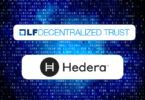Today the public distributed ledger (DLT) Hedera Hashgraph released its Hedera consensus service (HCS), which can be used by external centralized applications and other blockchains such as Hyperledger Fabric. Hedera is the DLT that has ten large corporates on its governance board, including Boeing, Deutsche Telekom, Google, IBM and Nomura.
The core features of a distributed ledger are an ordered log of transactions and smart contracts.
Ignoring smart contracts for a moment, a distributed ledger’s consensus is the process that orders and timestamps a series of data often as hashes or digital fingerprints of data held elsewhere.
Why does ordering matter? In something like an auction, the order of the bids are essential. Likewise, for trading securities, which offer and bid came first matters. But the sequence of events matters for most things, for example, the order of messages you receive when having a chat.
What’s different about the Hedera consensus service, is it can be used not just for the Hedera DLT but as a service externally. So a private blockchain using Hyperledger Fabric can use the Hedera consensus service to determine the timestamps and order of transactions. The whitepaper on the topic was written in conjunction with a member of the IBM Blockchain team – IBM is one of the members of Hedera’s governing council.
Hedera also claims it can be used for a private Corda or Ethereum network.
The ability to use a public consensus service is mainly a benefit in a small private network. Blockchains are meant to be immutable. But in a private blockchain with a small number of participants, the lack of decentralization means it’s entirely possible to have collusion. Small networks tend only to have one or two consensus nodes.
By having a public DLT do the time stamping, it becomes immutable. So it combines the trust of a public ledger with the privacy of a private blockchain.
But it’s not just a blockchain that could use it. Any centralized application might need some verification that its data is correct. For example, an audit log could use it if the log needed to be externally verified. Or a centralized auction app could use it to prove the bids were not manipulated.
Another advantage is that Hedera has split its consensus service from the comparatively slow smart contract service, which means it’s fast. It’s also robust because it’s asynchronous which makes it harder to disrupt it with a denial of service (DOS) attack.
But we had some questions for Hedera and didn’t get a response before publication.
First of all, one of the benefits is to achieve decentralization. While Hedera aims to have 39 governing council members and be permissionless in the future, for now we believe only the 11 council members (Google joined yesterday) operate nodes with write permissions. And we don’t know if some of the nodes are managed on their behalf.
We also aren’t clear what the current speed is. At launch in September, the cryptocurrency transactions were throttled to 10,000 transactions per second. We assume the consensus service is at least this speed.
Prior to launch, the platform raised $124 million through a token sale. Its novel technical architecture makes it faster and more scalable than most blockchains. The underlying intellectual property is licensed by Swirlds, which is owned by the founders of the network. We don’t believe the codebase has yet been subject to general review.
An observation: we’re starting to see the decoupling of key blockchain features as standalone services. For example, Hedera for consensus, DAML for smart contracts.






